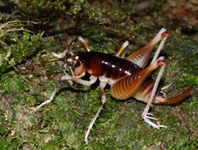Abstract
Two new species of eriophyoid mites from Fars province, Iran, are described and illustrated, namely: Tetra aparinea n. sp. causing distortion of Galium aparine L. (Rubiaceae) and representing the first record of the genus Tetra on plants of the family Rubiaceae; and Acaralox shiraziensis n. sp. from Tragopogon graminifolius DC. (Asteraceae), causing no visible damage except for slight wilting.
References
Amrine, J.W. Jr. & Stasny, T.A. (1994) Catalogue of the Eriophyoidea (Acari:Prostigmata) of the World. Indira Publishing house, West Bloomfield, Michigan, 798 pp.
Amrine, J.W. Jr., Stasny, T.A. & Flechtmann, C.H.W. (2003) Revised keys to world genera of Eriophyoidea (Acari: Prostigmata). Indira Publishing House, Michigan, 244 pp.
Briese D.T. & Cullen J.M. (2001) The use and usefulness of mites in biological control of weeds. In: Halliday, R.B., Walter, D.E., Proctor, H.C., Norton, R.A. & Colloff, M.J. (Eds.), Acarology: Proceedings of the 10th International Congress. CSIRO Publishing, Melbourne, pp. 453–463.
Craemer, C., Sobhian, R., McClay, A.S. & Amrine Junior, J.W. (1999) A new species of Cecidophyes (Acari: Eriophyidae) from Galium aparine (Rubiaceae) with notes on its biology and potential as a biological control agent for Galium spurium. International Journal of Acarology, 25 (4), 255–263.
https://doi.org/10.1080/01647959908684162de Lillo, E., Craemer, C, Amrine, J.W. Jr. & Nuzzaci, G. (2009) Recommended procedures and techniques for morphological studies of Eriophyoidea (Acari: Prostigmata). Experimental and Applied Acarology, 51, 283–307.
https://doi.org/10.1007/s10493-009-9311-xKamali, H. & Soleimani, R. (2006) A new Acaralox species (Acari: Eriophyidae) from Bermudagrass in Iran. International Journal of Acarology, 32, 185–187.
https://doi.org/10.1080/01647950608684459Keifer, H.H. (1939) Eriophyid studies V. Bulletin of the California Department of Agriculture, 28, 484–505.
Keifer, H.H. (1944) Eriophyid studies XIV. Bulletin of the California Department of Agriculture, 33, 18–38.
Keifer, H.H. (1966) Eriophyid studies B–21, Bureau of Entomology, California Department of Agriculture, 19661–19662.
Kuang, H.Y. (2002) Two new species of Eriophyinae from China (Acari: Eriophyidae). Acta Entomologica Sinica, 45, 115–117.
Li, D.-W., Lan, X. & Wei, S.-G. (2009) A new species of Acaralox (Acari, Eriophyoidea) infesting mangrove, Avicennia marina (Forsk.) Vierh., from China. Acta Zootaxonomica Sinica, 34, 868–870.
Lindquist, E.E. (1996) External anatomy and systematics. In: Lindquist, E.E., Sabelis, M.W. & Bruin, J. (Eds.), Eriophyoid mites: their biology, natural enemies and control. World Crop Pests, 6, pp. 383–396.
Lindquist, E.E. & Amrine, J.W. (1996) Systematics, diagnoses for major taxa, and keys to families and genera with species on plants of economic importance. In: Lindquist, E.E., Sabelis, M.W. & Bruin, J. (Eds.), Eriophyoid Mites: Their Biology, Natural Enemies and Control. World Crop Pests, 6, pp. 33–88.
https://doi.org/10.1016/S1572-4379(96)80004-2Manson, D.C.M. (1984) Eriophyoidea except Eriophyinae (Arachnida: Acari). Fauna of New Zealand, 4, 1–144.
Monfreda, R., Nuzzaci, G. & de Lillo, E. (2007) Detection, extraction and collection of Eriophyoid mites. Zootaxa, 1662, 35–43.
Nalepa, A. (1898) Eriophyiden (Phytoptiden). Das Tierreich, 4, 1–74.
Nalepa, A. (1892) Neue Arten der Gattung Phytoptus Duj. und Cecidophyes Anzeiger der kaiserlichen Akademie Wissenschaften. Mathematischenaturwissenschaftliche Klasse, Wien, 59, 525–540, pls. 1–4.
Oldfield, G. (2005) Biology of gall-inducing Acari. In: Raman, A., Schaefer, C.W., Withers, T.M. (Eds.), Biology, ecology and evolution of gall-inducing arthropods. Science Publishers, Inc., Enfield, NH, pp. 35–57.
Ripka, G. (2015a) A new Acaralox species (Acari: Prostigmata: Eriophyoidea) on Verbena officinalis L. from Hungary. Acta Zoologica Academiae Scientiarum Hungaricae, 61 (3), 247–254.
https://doi.org/10.17109/AZH.61.3.4.2015Ripka, G. (2015b) New Aceria and Acaralox species (Acari: Prostigmata: Eriophyoidea) from Hungary on Alcea rosea L. (Malvaceae) and Agrimonia eupatoria L.(Rosaceae). Acta Phytopathologica et Entomologica Hungarica, 50 (2), 209–221.
https://doi.org/10.1556/038.50.2015.2.6Skoracka, A. (2002) Two new species of eriophyoid mites (Acari: Eriophyoidea) from grasses in Poland. Zootaxa, 54 (1), 1–15.
https://doi.org/10.11646/zootaxa.54.1.1Skoracka, A., Labrzycka, A. & Rector, B.G. (2009) Three new species of eriophyoid mites (Acari: Prostigmata: Eriophyoidea) from grass hosts in Croatia. Annals of the Entomological Society of America, 102, 12–19.
https://doi.org/10.1603/008.102.0102Skoracka, A., Smith, L., Oldfield, G., Cristofaro, M. & Amrine, J.W. (2010) Host-plant specificity and specialization in eriophyoid mites and their importance for the use of eriophyoid mites as biocontrol agents of weeds. Experimental and Applied Acarology, 51 (1), 93–113.
https://doi.org/10.1007/s10493-009-9323-6Smith, L., de Lillo, E. & Amrine Junior, J. (2009) Effectiveness of eriophyid mites for biological control of weedy plants and challenges for future research. In: Ueckermann, E.A. (Ed.), Eriophyoid Mites: Progress and Prognoses. Springer, New York, pp. 115–149.
https://doi.org/10.1007/978-90-481-9562-6_7

